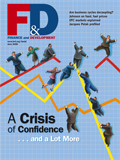 About F&D Subscribe Back Issues Write Us Copyright Information Free Email Notification Receive emails when we post new
items of interest to you. |
Melting mountains Glaciers are melting at a record rate, and the United Nations Environment Program (UNEP) is urging countries to agree on a new emissions reduction pact to help stem the shrinking of a vital source of water for hundreds of millions of people around the world. According to the UNEP-backed World Glacier Monitoring Service (WGMS), data from nearly 30 reference glaciers in nine mountain ranges indicate that the average rate of melting and thinning more than doubled between 2004/05 and 2005/06—a development caused at least in part by rising temperatures triggered by increased emissions of pollutants. "The latest figures are part of what appears to be an accelerating trend with no apparent end in sight," warns Wilfried Haeberli, WGMS Director. Counting the cash India tops the list of countries that receive remittances from its citizens living in other countries. Indians living abroad sent home $27 billion in 2007. China, Mexico, and the Philippines were the next largest recipient countries, according to the World Bank's Migration and Remittances Factbook 2008. "In many developing countries, remittances provide a lifeline for the poor," said Dilip Ratha, senior economist and coauthor of the report. Although South-South migration is almost the same as South-North migration, rich countries are still the main source of remittances, led by the United States. The United States was also the top immigration country in 2005, with 38.4 million immigrants, followed by Russia with 12.1 million and Germany with 10.1 million. While international migration is dominated by the voluntary movement of people, the report notes that there were 13.5 million refugees and asylum seekers, comprising 7 percent of global migrants. As migrant remittances have ballooned in size, they have caught the attention of high-level policymakers. For 2007, recorded remittance flows worldwide were estimated at $318 billion, of which $240 billion went to developing countries. These flows do not include informal channels, which would significantly enlarge the volume of remittances. Greater voice at the Fund In a key step toward reforming the IMF, the institution's highest decision-making body—the Board of Governors— adopted a resolution on April 28 to increase the voting shares of more than two-thirds of its 185 member countries. The changes will enhance the participation and voice of emerging market and developing countries and realign members' shares with their real economic weight in the world economy. In addition, the two Executive Directors representing African constituencies will each be able to appoint an additional Alternate Director. "As a result of these changes, the Fund's quota and voting structure will be more dynamic and forward looking," IMF Managing Director Dominique Strauss-Kahn said. The resolution was supported by 95 percent of the institution's members. The reform of country representation is part of a two-year program approved at the 2006 Annual Meetings in Singapore, when initial ad hoc increases in quotas were agreed on for China, Korea, Mexico, and Turkey. A country's quota at the IMF largely determines its voting power in the institution. Smaller is better New IMF research analyzes the link between country size, government size, debt, and economic performance and finds that on average small states have larger governments and higher public debt than large countries. States with smaller governments and lower public debt tend to grow faster and are less vulnerable. Using a new fiscal dataset for 42 small states, the analysis shows that small states tend to have higher government expenditures, including spending on goods and services, wages and salaries, and capital investment. The study—IMF Working Paper 08/39, "Big Government, High Debt, and Fiscal Adjustment in Small States"—says that the most effective way to achieve fiscal adjustment is to reduce spending. The results also suggest that improving governance may also help small states reduce public and external debt and thus support fiscal adjustment. More women working More women are working than ever before, but they are also more likely than men to get low-productivity, lowpaid, and vulnerable jobs, with no social protection, basic rights, or voice at work, says a new report by the International Labor Organization. Whereas 10 years ago agriculture was still the main employer for women, the services sector now provides the majority of female jobs: out of the total number of employed women in 2007, 36.1 percent worked in agriculture and 46.3 percent in services. Male sectoral shares in comparison were 34.0 percent in agriculture and 40.4 percent in services. Global Employment Trends for Women, 2008, says that the number of employed women grew by almost 200 million, or 18.4 percent, over the past decade, to reach 1.2 billion in 2007, compared with 1.8 billion men. But the number of unemployed women also grew from 70.2 million to 81.6 million over the same period. Worldwide, the female unemployment rate stood at 6.4 percent, above the male rate of 5.7 percent. The report also shows that the share of women in vulnerable employment—either unpaid contributing family workers or own-account workers, rather than wage earners and salaried workers—has decreased from 56.1 percent to 51.7 percent since 1997. However, the vulnerable share is still larger for women than for men, especially in the world's poorest regions. Events in 2008 June 3–4, Paris, France June 9–11, Cape Town, South Africa June 26–27, Basel, Switzerland July 7–9, Hokkaido, Japan August 3–5, Melbourne, Australia September 2–4, Accra, Ghana |